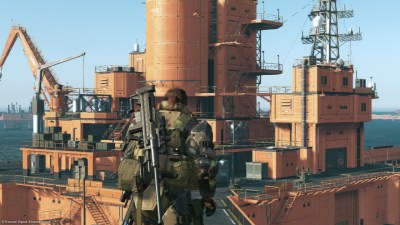Metal Gear Solid: Peace Walker continues the journey of the greatest mercenary who ever lived - Big Boss.
Following the events of MGS3: Snake Eater and MGS: Portable Ops, the game is set in 1974 and takes place in and around Costa Rica. Big Boss (now known simply as Snake) has been hard at work building up his mercenary unit, Militaires Sans Frontières, with the help of his long-trusted ally and friend Kazuhira Miller.
Not all is well in the world, though. Snake has been troubled ever since killing his previous mentor, the Boss, who will wrongly go down in history as one of the United States’ notable traitors.
Ten years since the events of MGS 3, a group known as the Peace Sentinels have been deployed in Cuba, and are equipped with the latest and greatest weapons - including a nuclear arsenal. Since it goes against Cuba’s constitution to create an armed forces group, the Peace Sentinel’s presence is a game-changer between the East and West. So far, so familiar – fans of the franchise are used to series producer Hideo Kojima using Metal Gear games as a way of exploring the various philosophies surrounding life, death, war and peace – and everything in-between.
It isn’t long before Snake’s assistance is requested, which he turns down. MSF isn’t just a mercenary unit, after all, but a group of soldiers who fight for those who can’t fend for themselves. But when a tape recording comes his way that seems to prove that his dead mentor is still alive, he agrees to help out. Once he takes up the offer, it’s up to him to set the Peace Sentinels straight. In one of the series’ least convoluted stories, Snake sets out to simultaneously stop a Metal Gear (a bipedal war-tank) from launching a nuclear warhead, and to discover whether or not the Boss is still alive.
Snake is clearly not over the events that happened ten years ago however; he wants answers to some of the unresolved questions arising from the events of Snake Eater, and he also wants revenge. He had to kill the woman he loved for his country, and he can’t help but to ask himself why she would have defected to the Soviet Union. The wound of her death is still so tender that this battle-hardened soldier openly cries about the events that happened, and Snake’s fragile emotional state is a constant theme throughout the game’s narrative.
Just as with Peace Walker’s handheld predecessor - Portable Ops - this entry eschews the traditional real-time gameplay, more strongly resembling an RTS. You’ll develop your base and recruit new soldiers, in-between engaging in bite-sized missions.
Enemy soldiers don’t just wander aimlessly around the lush backdrop, but rather, they actively guard the territory they’re given. Snipers in ghillie suits can be amazingly difficult to spot, but this adds a fun layer to sneaking around. Enemies that are knocked unconscious can be kidnapped using the Fulton System (which sends them back to Snake’s base via a giant balloon that gets snagged by a plane), to build up Snake’s army, which is a much-appreciated improvement on the Portable Ops system in which Snake had to drag the soldiers to the back of a truck at a snail’s pace.
Snake’s base - Outer Heaven - is located in the middle of the ocean. As the setting for the very first Metal Gear game, there’s a pleasing twinge of nostalgia from seeing this important piece of series lore come to life.
Outer Heaven is also where the true depth of the game comes into play. Every soldier or POW that you capture becomes an addition to Snake’s team, and each person plays an important role in how smoothly the day-to-day functions of Mother Base operate. Certain soldiers will be better equipped for kitchen duties, while others may have rare R&D knowledge that will give Snake access to improved items, weapons, and upgrades. You can deploy them in the main missions, or dispatch them into the world on their own, in missions called Outer Ops. The more people that Snake acquires, the stronger his overall unit becomes.
While missions are much shorter than the home console entries of the series – befitting the more bite-sized requirements of handheld gameplay - this doesn’t take away from the overall production values. Each mission is replayable, so if you only have time for a quick run-through of a single level, you’re able to go back later and explore the environment more thoroughly.
The result is a game that manages to both progress the series’ gameplay and stay true to its extensive lore, while suiting a more piecemeal playstyle.
Peace Walker is highly addicive; building up and creating the best team possible provides a fun and unique take on what the series is capable of. You’ll lose hours of your time building up Snake’s legendary army, and the feeling of creating an increasingly powerful force is entirely captivating. Many features are taken directly from Snake Eater: the camo index and changing fatigues, and CQC (Close Quarter Combat) all return, capitalizing on what both MGS3 and MGS4 made possible.
Before each mission, the player can choose Snake’s loadout and camouflage, and any items that Snake acquires during the mission beyond his weight-carrying limit are transported directly to Mother Base.
Of course, while the game debuted on handheld, it also benefited from a port to home consoles. Playing on the big screen does highlight some of the game’s graphical shortcomings, but the controls feel natural to the series, and the CQC is just as in-depth as ever.
Outside of the main single-player campaign, Peace Walker features co-op multiplayer, which allows two players the chance to play missions together and up to four players the ability to engage in boss fights. Some missions are exclusively multiplayer, such as “Snake-in,” which requires you holding on to each other as one teammate leads the way. In a neat touch, you’re able to perform CPR on fallen comrades.
Complementing the co-operative mode is Versus-Ops, which is essentially MGS: Online, only scaled down to be more suited to handheld play. Versus-Ops offers individual and team deathmatch modes, base capture, and catch missions. While it’s certainly enjoyable, we found that Co-Op play was more enjoyable.
Complete the campaign and become bored of multiplayer, and there’s an insane amount of additional content to be found. Listening to bird calls, taking photos of ghosts, and holding people up with bananas are just a slight taste of the offering of supplementary content that Peace Walker comes loaded with. We won’t dare spoil any more, lest we ruin the fun of discovering the rest for yourself.
Overall, Peace Walker shines as a testament to what the Kojima’s long-running series is able to do, and even though it’s not perfect, it’s a hell of a lot of fun. We actually struggled to find fault with it, though if we’re being picky, some of the boss battles aren’t very memorable for a series which is hardly short on memorable encounters, and the required co-op missions can become frustrating. It’s also a game that doesn’t offer much information in the way of tutorials, making learning how to optimize your squad and get the most out of the game a distinct challenge.
None of this, however, detracts from what Peace Walker does right: and that’s no small list.


